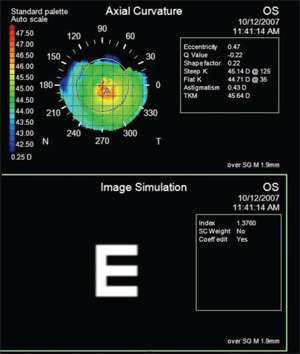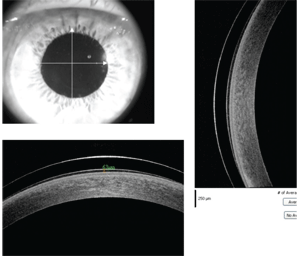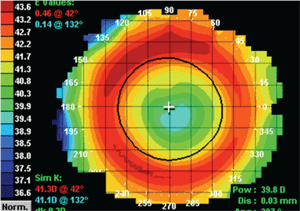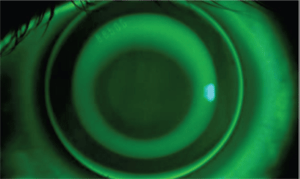Contact lens manufacturers have made low-cost molded lenses widely available to consumers. As a result, contact lens fees and annual lens costs are a fraction of what they were two decades ago (in inflation-adjusted dollars). At the same time, the average consumer may view contact lenses as a commodity, seeing no appreciable difference between market-leading lenses and lacking awareness of lenses that solve problems when other lenses fall short. What’s worse is that patients may not care where their lenses come from and have no appreciation for the distinct care received from one eye care practitioner vs. another.
Does this reality result in optimized patient satisfaction with contact lenses? If it does, then why do more than three million patients stop wearing lenses every year? One possible answer is dissatisfaction with their current lenses. When the needs and preferences of the patients are not satisfied with the market-leading commodity offerings, the practitioner has an opportunity to educate and guide them toward more suitable lens wear while underscoring his or her own expertise.

Topography over SynergEyes
Multifocals demonstrates position of near segment within the pupil and
simulated defocus of 20/20 letter from simultaneous vision optics.
The Satisfaction Gap
Years ago, I wrote an article titled, “Our Two Most Powerful Tools,” referring to case history and consultation.1 As a result of crunched scheduling, higher daily patient volumes and the shift of primary care to a medical model, most practitioners likely spend less time on case history than in the past, which often leads to a reduced opportunity for discovering unmet patient needs and wants with regard to their contact lens experiences.
So how do you measure up? Consider taking a personal survey of your case history methods and practices. Do your inquiries successfully uncover patients’ reduced comfortable wearing times? Are you able to identify a successful wearer who is near to dropping out because of shortcomings in the lenses’ visual performance for certain tasks? Case history, more than any clinical measure, is an indicator for considering the armament of lenses outside the high market share of disposable spherical, toric and multifocal lenses.
Each time a patient enters your office with an implicit need left unexplored during the case history, and for which treatment alternatives are not offered during consultation, this patient walks out with a need left unmet, and you lose an opportunity to be compensated for higher-value services and materials. I refer to this as ophthalmic entropy—the conversion of potential ophthalmic care and economic return into a non-usable form. Such a conversion is a clear lose-lose situation; the patients lose because their needs was not found or treated, and you lose by prescribing lower-margin products. You also lose by failing to stimulate the enthusiasm that comes with higher satisfaction, which is more likely to result in increased patient retention and referrals.
Improving Case History: Two Minutes to Discovery
Consider adding two minutes to your case history portion of the exam, and incorporate some of the following questions:
• Tell me the three things you most dislike about your current vision correction (contact lenses or spectacle eyewear).
• How many hours per day do you wear your lenses? How many of those hours are comfortable?
• During which tasks do your lenses most let you down? Where do you struggle the most with your vision?
• If you could “wiggle your nose” and change anything about your contact lenses, what would it be?
All of these questions are designed to discover shortcomings that you won’t discover by asking the typical questions: “How are you doing with your eyes and vision? Are you having any problems with your lenses? What brings you in today?” Culturally, Americans are simply too accustomed to saying “Fine,” or “Good.” when someone asks, “How are you?” Problems are bottled up and forgotten, and patients only realize that they should have reported a nuisance when they get home.
Clinical Considerations for Extraordinary Prescribing

Proclear Mutifocal Toric provides a distance-center and near-center design, which may be prescribed for contralateral eyes.
Today’s toric lenses are quite advanced—even though they fall short of the power and axis offerings of spectacle lenses and lens orientation, and even though their rotational stability compromises acuity. In a randomized crossover study at the University of Michigan, subjects wore a pair of market-leading toric lenses and then a pair of SynergEyes hybrid lenses. At the end of the study, patients were asked which modality they preferred. Forty-four percent preferred the hybrid lenses.2 Those who preferred the hybrid lenses enjoyed the improved visual acuity, while those who selected the soft toric lenses cited improved comfort as the reason. This is why your armamentarium should include both soft toric lenses and hybrid lenses to satisfy all patients. In my experience, hybrid lenses provide better acuity on average and should be considered for patients who complain of compromised vision with soft lenses or for those who report that visual acuity is very important to them.
Refer back to the case history questions, “How many hours a day do you wear your lenses?” and, “How many of those hours are comfortable?” It is common for a patient to report 16 hours of wearing time and 12 or 13 hours of comfort. This is your opportunity to offer a treatment plan that includes testing a series of lenses over a 90-day period. You can include conventional and silicone hydrogel materials to challenge the current lens modality in an effort to increase comfortable wearing time. Keep in mind that oxygen delivery only addresses one health maintenance objective. Some patients will experience increased comfortable wearing time with conventional materials. The range of material properties and surface characteristics of lenses provide different benefits to the continuum of patients.
Additional strategies to consider include modulating care products, training blink quality and quantity, recommending nutraceuticals and suggesting environmental engineering (e.g., with regard to proximity and direction of air conditioners and changing of HVAC filters).
Multifocal or Monovision: The Power is in the Question
Most practitioners today adhere to the maxim, “If it ain’t broke, don’t fix it.” While this makes good sense and is particularly wise in the face of full schedules, the operative word is “broke.” How do we, as eye care practitioners, know if it’s broke or not when it comes to the contact lens dropout rate, if we don’t ask our patients? If we don’t know it’s broke, we can’t fix it, and patients will wane in their enjoyment of contact lenses until they finally drop out. Ask the suggested case history questions, and you may find that the patient is dissatisfied with monovision. You can recommend a presbyopic contact lens evaluation during your consultation. Today’s variety of toric multifocals, hybrid multifocals and a wide range of GP multifocals offer extensive opportunities to prescribe beyond the ordinary.
Soft Contact Lenses or CRT
While we all have varying opinions on the value of myopia progression regulation, there is substantial evidence that the modulation of peripheral retinal defocus through use of distance center multifocal contact lenses or corneal reshaping with corneal refractive therapy (CRT) lenses is efficacious.3-5
Reserve your judgment. CRT has a long history of providing temporary therapeutic correction for myopia, with and without astigmatism. If, during your case history, you discover the patient’s preference for spending waking hours free of spectacles or contact lenses and an aversion to refractive surgery, you have an opportunity to prescribe beyond the ordinary! CRT patients are enthusiastic about and appreciative of their ability to function correction-free during the day. Further, there is anecdotal evidence of resolution of dry eye symptoms previously reported by patients.

Optical coherence tomography of an RGP scleral lens and cornea demonstrates apical clearance.
Consultative Prescribing: Create a Nexus
The post-examination consultation is the opportunity to pull together the discovery in the case history and the clinical findings. The word nexus means a substantive connection. Your consultation should create a connection between the needs, wants and preferences made clear in the case history and your treatment alternatives and recommendation. Clinical findings can be referenced to provide a basis for your recommended treatment.
In each of the aforementioned case examples, the practitioner discovered a need, want or preference during the case history and connected it with a treatment option that is supported by the clinical findings. Usually, this form of consultative prescribing requires little or no persuasion.
Examples of Consultative Prescribing
Our experts provided consultative prescribing examples similar to the following. The key to each example is a paraphrasing of the patient’s elicited need, want or preference, the clinical findings that are relevant and a recommendation that is connected to the case history report.
• “You reported that only 12 of your 16 hours of contact lens wear are comfortable. You are wearing brand X silicone hydrogel disposable lenses. I recommend that we test you over the next 90 days with four different materials and designs to see if we can extend your comfortable wearing time.”

CRT,
the effects of which are seen on this corneal topography, is under
investigation for desirable peripheral defocus to regulate myopia
progression.
• “You reported the inability to read in dim light. You are currently using monovision correction, and your examination revealed uncorrected astigmatism. Your clinical findings revealed a significant astigmatism along with the need for bifocal correction. I recommend brand Y soft toric multifocal lenses. The use of multifocal lenses gives you the advantage of summation, where you see better with both eyes together than you do with each eye separately.”
• “You reported difficulty seeing at all distances and most particularly, in the far distance. Your clinical findings support your previous diagnosis of keratoconus, and your irregular astigmatism is greater than your soft lenses can correct. Your work environment is dusty and dirty, contraindicating corneal GP lenses. I recommend scleral lenses, which provide the benefits of your soft lenses with regard to foreign body migration under your lenses, as well as improved visual acuity.”
• “You reported that your child is active and dislikes wearing spectacles or contact lenses at school and during sports. The clinical findings indicate a continued progression in myopia from last year’s examination. I recommend corneal refractive therapy, contact lenses that are worn during sleep and removed in the morning; they will reshape the cornea and correct your child’s vision for the entire day. In addition to not having to wear contact lenses or glasses during the day, there is evidence that this method may prevent myopia from progressing further.”
• “You reported that your reading vision is adequate, but when you drive, your vision is insufficient; you remove your lenses and drive with your spectacles. You also stated your preference for sharp distance vision and not wanting to wear spectacles in the evening. Your clinical findings revealed astigmatism, nearsightedness and presbyopia. I recommend the SynergEyes multifocal. The rigid optics will provide clear distance and near vision in each eye.”
Don’t Second Guess Pocketbooks

This fluorescein pattern shows a well-fit lens for overnight corneal refractive therapy for myopia with or without astigmatism.
Most would agree that Americans today have less available cash, and there is a heightened awareness for the costs of living and healthcare. Even so, people consistently demonstrate that they don’t mind spending money on the things they really want. This is why it is always best to recommend a treatment that has the potential to improve their life. Worst-case scenario: Patients can say no or put off following your recommendation until a later date.
Prescribing in the best interest of patients is prescribing to enhance the quality of their lives. If they accept your recommendations and the treatments satisfy their needs, wants or preferences, they will be enthusiastic and will appreciate your care. Further, they will differentiate you from other practitioners and will elevate extraordinary lenses over commodity lenses.
Dr. Legerton is an author, lecturer, inventor and consultant to the ophthalmic industry. He was the managing partner of a seven-doctor practice in San Diego for 26 years. He was the co-founder of SynergEyes, and his 22 issued U.S. patents and more than 30 pending applications include inventions for corneal refractive surgery for presbyopia, Paragon CRT, hybrid contact lenses, regulation of myopia progression, scleral contact lenses and contact lenses for wearable displays.
Robert Gordon, O.D., F.A.A.O., Encino, Calif.
Dianne Anderson, O.D., F.A.A.O., Chicago, Ill.
Brian Chou, O.D., F.A.A.O., San Diego, Calif.
Walter Choate, O.D., F.A.A.O., Nashville, Tenn.
“Daniel,” a 56-year-old male, is an avid reader and a competitive
sharpshooter who wears PureVision (Bausch + Lomb) multifocal lenses.
His case history elicited decreased near vision and adequate but not
optimal distance vision. Manifest refraction and add requirement were
-2.75 - 0.75 x170 O.D. and
-2.50-0.75x170 O.S. with a +2.50D add O.U. Keratometry readings were
41.25 / 42.50 O.D. and 41.25 / 42.25 O.S. Daniel was prescribed and followed with
SynergEyes Multifocal lenses. His manifest refraction was now -4.00
7.8/8.8 /1.9 +1.75 O.D., and -3.25 7.9/8.9 / 1.9 + 1.75 O.S. The
patient returned and reported, “I love my vision with these lenses!
It’s great at distance and near with both lenses; I can never feel
them, even after 14 hours of wear.” His best-corrected visual acuity
measurements were 20/20-1, J-1 O.D. and 20/20, J-1 O.S.
Lee Rigel, O.D., F.A.A.O., East Lansing, Mich.
“Nicholas,” a 14-year-old male with spherical myopia,
had been wearing silicone hydrogel disposable lenses for approximately
two years. Since the time of his initial contact lens fitting, his
myopic correction more than doubled to -3.50D, and both he and his
parents were interested in a contact lens-based corneal reshaping
approach in an attempt to reduce the rate of his myopic progression. CRT lenses (Paragon Vision Sciences)
were prescribed, and Nicholas was able to achieve 20/20- uncorrected
vision in both eyes with no residual refractive error. He has
manifested no increase in his myopia during the 2.5 years of wearing
this modality. He is able to wear his CRT lenses every other night and
still maintain his emmetropic status.
“Mitch,” a 52-year-old male attorney with moderately advanced
pellucid marginal degeneration, presented wearing custom toric soft
contact lenses that provided excellent comfort but poor vision due to
monocular diplopia. He had tried several RGP corneal lenses in the
past, yet he was never able to obtain adequate comfort or prevent the
lenses from dislodging on lateral eye movement. Clinical findings
included inferior ectasia in both eyes with 5.00D of astigmatism in the
right eye, and 6.50D in the left eye—both at oblique axes. Mitch was reluctant to try RGP corneal
lenses again due to his history. He was presented with the options of
being fit with SynergEyes Clear Kone lenses or RGP scleral contact
lenses. Due to fitting issues, he was ultimately fit with RGP scleral
lenses, which eliminated his monocular diplopia and provided excellent
visual acuity and comfort for up to 15 hours per day.
“Claire,” a 48-year-old female, had successfully worn a
spherical RGP for distance O.D. and a bitoric RGP lens O.S. for near
for four years. After discontinuing lens wear for eight months during
chemotherapy treatment for breast cancer, she reported discomfort and
decreased wearing time with her RGP lenses. Claire’s spectacle Rx:
-3.50 -1.50 x 180 20/20 O.D. and -2.50 -2.50 x 010 20/20 O.S., with a
+1.75D add O.U. Refitting into soft toric monovision
lenses improved her comfort and wearing time, but the visual acuity at
both distance and near was decreased. Her best-corrected soft toric
monovision acuity, with Air Optix for Astigmatism (CIBA Vision), was
8.7/14.5 O.U., -3.50 -1.25 x 180 (distance) O.D., -1.00 -2.25 x 010
(near) O.S. Claire’s distance visual acuity was 20/30 O.U., and her
near visual acuity was 20/30 O.U. But, refitting with soft multifocal
toric lenses restored both distance and near acuity. The final lens was
the Proclear Multifocal Toric (CooperVision) 8.7.14.4. Claire was fit
with a D lens (Distance center) on her left eye, -3.50 -1.25 x 180 “D”
+1.50, and an N lens (Near center) on her right eye, -2.50 -2.25 x 010
“N” +1.50, resulting in a distance acuity of 20/20 O.U. and a near
acuity of 20/25+ O.U.
“Justin,” a 21-year-old male Division I collegiate golfer,
presented for a routine examination wearing AirOptix Aqua Night &
Day (CIBA Vision) 8.4 base curve -1.50D lenses O.U. He had no
complaints aside from needing more contact lenses. Justin reported
adhering to a daily removal regimen, and his visual acuity was 20/20+
O.U. Spherical-cylindrical over-refraction was plano - 0.50 x 085
yielding 20/15 O.D., and plano - 0.50 x 095 yielding 20/15 O.S.
Due to the patient’s high vision
demands, I refit him into Extreme H2O 54% Toric Low Cylinder lenses
(Hydrogel Vision) -0.65 DC, with a base curve of 8.6, -1.50 sphere, 090
axis O.U., resulting in 20/15 O.U. with a correlated improvement in
subjective vision.
1. Legerton JA. Our two most powerful tools. Optometric Economics 1994 June.
2. Lipson MJ, Musch DC. Synergeyes versus soft toric lenses: vision-related quality of life. Optom Vis Sci. 2007 Jul;84(7): 593-7.
3. Aller TA, Wildoset C. Bifocal soft contact lenses as a possible myopia control treatment: a case report involving identical twins. Clin Exp Optom 2008 Jul;91(4):394-9.
4. Cho P, Cheung SW, Edwards M. The longitudinal orthokeratology research in children (LORIC) in Hong Kong: a pilot study on refractive changes and myopic control. Curr Eye Res. 2005 Jan:30(1):71-80.
5. Walline JJ, Jones LA, Sinnott LT. Corneal reshaping and myopia progression. Br J Ophthalmol. 2009 Sep;93(9):1181-5.


